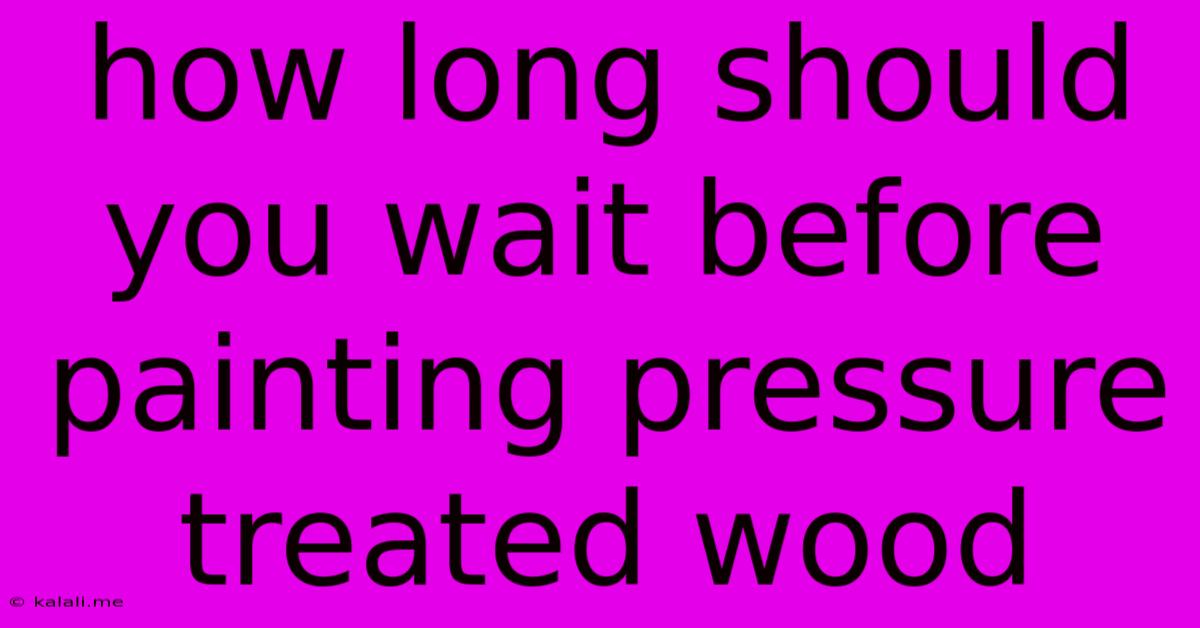How Long Should You Wait Before Painting Pressure Treated Wood
Kalali
Jun 01, 2025 · 4 min read

Table of Contents
How Long Should You Wait Before Painting Pressure Treated Wood? A Comprehensive Guide
Meta Description: Wondering how long to wait before painting pressure-treated wood? This guide covers drying times, paint types, and best practices for a long-lasting, beautiful finish. Learn the secrets to a successful paint job!
Pressure-treated wood is a popular choice for outdoor projects due to its durability and resistance to rot and insects. However, before you can enjoy its beauty with a fresh coat of paint, you need to understand the crucial aspect of proper drying time. Rushing the process can lead to peeling, blistering, and a shorter lifespan for your paint job. This guide will delve into the specifics of how long you should wait before painting pressure-treated lumber, and the factors influencing this timeframe.
Understanding the Drying Process
Pressure-treated wood is infused with preservatives, typically copper azole, chromated copper arsenate (CCA), or micronized copper quat (MCQ). These preservatives are crucial for protection but also contain moisture that needs to dry before painting. The drying time depends on several factors:
- Type of wood: Denser woods like cedar and redwood naturally dry slower than softer woods like pine.
- Thickness of the lumber: Thicker boards will take longer to dry completely.
- Climate: Hot, dry climates accelerate drying, while humid, cool conditions prolong the process.
- Treatment method: The specific treatment method used by the manufacturer can influence the drying time.
The Minimum Waiting Period
While there's no one-size-fits-all answer, a general guideline is to wait at least 2-4 weeks for the wood to dry sufficiently before applying paint. This timeframe allows for adequate surface drying, reducing the risk of moisture trapping beneath the paint. However, this is a minimum; longer is often better.
How to Check if Your Wood is Dry Enough
Don't just rely on the calendar. Here are some ways to verify if your pressure-treated lumber is ready for painting:
- Moisture Meter: The most reliable method is using a moisture meter. Aim for a moisture content of 12-15% or lower. Higher moisture levels indicate the wood isn't dry enough.
- Visual Inspection: Look for signs of dryness. The wood should feel dry to the touch, with no visible dampness or beads of water. Avoid painting if the wood feels cool and damp.
- The “Thumbprint Test”: Press your thumb firmly onto the wood's surface. If a noticeable indentation remains, the wood is likely too wet.
Choosing the Right Paint for Pressure-Treated Wood
Selecting the appropriate paint is just as crucial as waiting for the wood to dry. Look for paints specifically formulated for exterior use and pressure-treated lumber. These paints are designed to withstand the elements and often contain mildew-resistant properties.
Consider these paint types:
- Oil-based paints: Offer excellent durability and water resistance, but require more time to dry and may release strong fumes during application.
- Water-based paints (acrylic): A popular choice for ease of use, faster drying times, and low odor. Ensure the paint is explicitly designed for exterior use and pressure-treated lumber.
- Solid Color stains: These offer color and protection while still allowing the wood grain to show through.
Priming Pressure-Treated Wood
While not always necessary, priming your pressure-treated wood before painting can enhance the paint's adhesion and longevity. Use a primer designed for exterior wood and pressure-treated lumber. This is particularly helpful with knotty wood or if you’re using a lighter-colored paint.
Best Practices for Painting Pressure-Treated Wood
- Clean the surface: Remove any dirt, debris, or mildew before painting. Use a pressure washer or stiff brush.
- Sand lightly: Lightly sanding the surface can help improve paint adhesion.
- Apply thin coats: Multiple thin coats are better than one thick coat. Allow each coat to dry thoroughly before applying the next.
- Follow the paint manufacturer's instructions: Always carefully read and follow the paint manufacturer's instructions regarding drying times and application methods.
By following these guidelines, you’ll ensure a long-lasting, beautiful finish on your pressure-treated wood project. Remember, patience is key—taking the time to properly prepare the wood will ultimately save you time and frustration in the long run.
Latest Posts
Latest Posts
-
Can You Play Mahjong With 2 Players
Jun 03, 2025
-
How To Start Automatic Car By Pushing
Jun 03, 2025
-
Why Are My Imessages Sending As Texts To One Person
Jun 03, 2025
-
Google Docs Shortcut To Insert Row Below In Table
Jun 03, 2025
-
What Happens When You Throw A Clock In The Air
Jun 03, 2025
Related Post
Thank you for visiting our website which covers about How Long Should You Wait Before Painting Pressure Treated Wood . We hope the information provided has been useful to you. Feel free to contact us if you have any questions or need further assistance. See you next time and don't miss to bookmark.